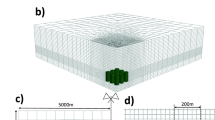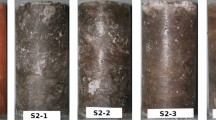Summary
Deformation of Rock Salt in Openings Mined for the Disposal of Radioactive Wastes
With the storage of high-level radioactive waste in salt structures, unique mine stability problems will occur as a result of the elevated temperatures. To predict flow in rock salt, scale models of salt pillars and their surrounding rooms were fabricated from cores taken in the Carey salt mine, Lyons, Kansas. Tests were conducted at temperatures of 22.5°, 60°, 100°, and 200°C for axial loads of 2000, 4000, 6000, 8000, and 10000 psi at each temperature. These tests showed that marked increases occur in the rates of deformation of salt pillars at high loads and especially at elevated temperatures. For all combinations of axial loads and temperatures, it was observed that there is initially a high rate of deformation that diminishes with time. Creep rates were found to continue to decrease even after more than 3 years of testing. An empirical relationship between pillar deformation, stress, temperature, and time was developed from the tests and is expressed as
where\(\dot \varepsilon\) = strain rate (in./in./hr),ε = cumulative deformation (in./in.),T = absolute temperature (°K),σ = average pillar stress (psi), andt = time (hr).
For comparative purposes, model pillar tests were conducted on samples of bedded salt, as well as dome salt from six different mines in the United States and from the anticlinal structure of the Asse II salt mine in Northeast Germany. In general, the deformational behavior for the various types of salt was similar at room temperature as well as at elevated temperature even though some variations in the rates of deformation were observed.
From model tests it was also observed that greatly accelerated rates of deformation will occur in excavated cavities where thin shale beds occur in the pillars at the roof and floor interfaces. Since the shalcs serve as friction reducers, effective confining stresses in the roof and floor are not transmitted into the pillars; thus the pillars under these conditions are weaker than where shale partings are not present at the tops and bottoms of the pillars.
Zusammenfassung
Verformung von Steinsalz in Schächten zur Beseitigung radioaktiver Abfälle
Bei der Lagerung stark radioaktiver Abfälle in Salzbergwerken treten wegen der erhöhten Temperaturen neuartige Stabilitätsprobleme auf. Um das Fließen im Steinsalz vorauszusagen, wurden maßstabgetreue Modelle von Salzträgern und ihrer umgebenden Räume aus Bohrkernen des Carey-Salzbergwerkes in Lyons, Kansas, hergestellt. Die Versuche wurden bei Temperaturen von 22,5°, 60°, 100° und 200°C und bei Achsenbelastungen von 2000, 4000, 6000, 8000 und 10000 Pfund per Quadratinch (psi) durchgeführt. Sie zeigten, daß bei hohen Belastungen und besonders bei erhöhten Temperaturen die Verformung der Salzträger merklich zunimmt. Bei allen Achsenbelastungs- und Temperaturkombinationen wurde beobachtet, daß die Verformungsgeschwindigkeit nach einem hohen Anfangswert mit der Zeit abnimmt. Die Kriechgeschwindigkeiten nahmen noch nach mehr als drei Jahren ab. Eine empirische Abhängigkeit zwischen Trägerverformung, Spannung, Temperatur und Zeit wurde aus den Tests gewonnen:
mit\(\dot \varepsilon\) = Verformungsgeschwindigkeit (in./in./hr),ε = kumulative Verformung (in./in.),T = absolute Temperatur (°K),σ = mittlere Trägerspannung (psi) undt = Zeit (hr).
Vergleichshalber wurden Modellversuche an Proben von Salzlagern sowie an Kuppelsalz aus sechs verschiedenen Bergwerken in den Vereinigten Staaten und aus dem antiklinalen Salz des Bergwerkes Asse II im nordöstlichen Teil Deutschlands durchgeführt. Im allgemeinen war das Verformungsverhalten der verschiedenen Salzarten bei Zimmertemperatur wie bei erhöhter Temperatur ähnlich, obwohl einige Abweichungen der Verformungsgeschwindigkeiten beobachtet wurden.
In weiteren Versuchen wurde beobachtet, daß die Verformungen in Hohlräumen, wo dünne Schieferschichten an den Dach- und Bodenzwischenflächen der Träger auftraten, wesentlich beschleunigt waren. Da die Schieferstücke als Reibungsreduktionsmittel fungieren, werden wirksame beschränkende Spannungen auf die Träger nicht übertragen; daher sind die Träger unter diesen Umständen schwächer als in Fällen in denen keine Schiefertrennungen an den oberen und unteren Enden der Träger vorhanden sind.
Résumé
Déformation du sel gemme dans des cavités minières pour des déchets radioactifs
Lors du stockage des déchets de haute radioactivité dans les formations géologiques de sel gemme les températures élevées causent des problèmes spéciaux de stabilité. Pour prévoir l'écoulement dans les formations de sel gemme on a construit des modèles réduits de piliers de sel à partir de carottes obtenues dans la mine de sel Carey à Lyons, Kansas. On a fait des essais à des températures de 22,5° 60°, 100° et 200°C, pour des charges axiales de 2000, 4000, 6000, 8000, 10000 psi à chaque température. Ces essais ont montré que les hautes charges augmentent sensiblement les vitesses de déformation, en particulier aux températures élevées. Pour toutes les combinaisons de charges axiales et de températures, on a observé qu'il y a au début une vitesse de déformation élevée qui diminue avec le temps. On a trouvé que les vitesses de fluage continuent à diminuer même après plus de trois ans d'essais. On a obtenu une relation empirique entre la déformation des piliers, la contrainte, la température et le temps, qui s'exprime ainsi:
avec\(\dot \varepsilon\) = vitesse de déformation (in./in./h),ε = déformation cumulée (in./in.),T = température absolue (°K),σ = contrainte moyenne dans le pilier (psi),t = temps (h).
A titre de comparaison, on a fait des essais sur modèles réduits avec des échantillons de sel gemme stratifié et de sel de dôme, provenant de six mines des États Unis, et de la structure anticlinale de la mine de sel Asse II dans le nord-est de l'Allemagne. En général, la déformation des différents types de sel à la température ambiante et aux températures élevées était similaire bien que l'on ait observé des variations des vitesses de déformation.
On a observé aussi par des essais sur modèles réduits que les vitesses de déformation sont augmentés considérablement lorsque les cavités contiennent des lits minces de schistes aux contacts du mur et du toit. Les schistes réduisent le frottement; les contraintes de confinement effectives dans le toit et le mur ne sont pas transmises dans les piliers; ainsi, dans ces conditions, les piliers sont moins résistants qu'en l'absence d'intercalation de schiste au sommet et à la base des piliers.
Similar content being viewed by others
References
Committee on Waste Disposal, Division of Earth Sciences, Disposal of Radioactive Wastes on Land. National Academy of Sciences-National Research Council Publication 519, Washington, D. C. (1957).
Bradshaw, R. L. et al.: Ultimate Storage of High-level Waste Solids and Liquids in Salt Formations, in Treatment and Storage of High-level Radioactive Wastes, 153–175, International Atomic Energy Agency, Vienna (1963).
Bradshaw, R. L. et al.: A Concept and Field-scale Test of Disposal of High Activity Power Reactor Wastes in Salt Mines, Transactions of the American Nuclear Society7 (2), 399–400 (1964).
Parker, F. L., L. Hemphill, and J. Crowell: Status Report on Waste Disposal in Natural Salt Formations, ORNL-2560, Oak Ridge National Laboratory, Oak Ridge, Tennessee (1959).
Medwenitsch, W.: Geological Institute, University of Vienna, Vienna, Austria, personal communication with R. L. Bradshaw (Oak Ridge National Laboratory) (1962).
Dellwig, L. F.: Flowage in Rock Salt at Lyons, Kansas. Kansas State Geological Survey Bulletin130 Part 4, 165–175 (1958).
Bradshaw, R. L., J. J. Perona, and J. O. Blomeke: Demonstration Disposal of High-level Radioactive Solids in Lyons, Kansas, Salt Mine: Background and Preliminary Design of Experimental Aspects, ORNL-TM-734, Oak Ridge National Laboratory, Oak Ridge, Tennessee (1964).
Bradshaw, R. L., et al.: Disposal of High Activity Power Reactor Wastes in Salt Mines: A Concept and Field Scale Demonstration, Nuclear Structural Engineering2 (4), 438–446 (Oct. 1965).
Boegly, W. J., Jr., et al.: Disposal of High Activity Power Reactor Wastes in Salt Mines: Mine Renovations Required for Project Salt Vault, Nuclear Engineering and Design (in press).
Schaffer, W. F., Jr., et al.: Project Salt Vault: Design of Equipment. Nuclear Engineering and Design (in press).
Lee, W.: Stratigraphy and Structural Development of the Salina Basin Area. Kansas State Geological Survey Bulletin121 167 (1956).
Pierce, W. G. and E. I. Rich: Summary of Rock Salt Deposits in the United States as Possible Storage Sites for Radioactive Waste Materials. United States Geological Survey Bulletin1148 38–41 (1962).
Serata, S.: Continuum Theory and Model of Rock Salt Structures, Second Symposium on Salt (Jon L. Rau, editor). The Northern Ohio Geological Society, Inc., Cleveland, Ohio, 1–17 (1966).
Obert, L. E.: Deformational Behavior of Model Pillars Made from Salt, Trona, and Potash Ore, in Proceedings of the Sixth Symposium on Rock Mechanics, Rolla, Missouri, 539–560 (1964).
Bradshaw, R. L., W. J. Boegly, Jr., F. M. Empson: Correlation of Convergence Measurements in Salt Mines with Laboratory Creep Test Data, in: Proceedings of the Sixth Symposium on Rock Mechanics, Rolla, Missouri, 501–514 (1964).
Bradshaw, R. L. et al.: Disposal in Natural Salt Formations, in Health Physics Division Annual Progress Report for Period Ending July 31, 1967, ORNL-4168, Oak Ridge National Laboratory, Oak Ridge, Tennessee, 18–31 (1967).
Author information
Authors and Affiliations
Additional information
Research sponsored by the U. S. Atomic Energy Commission under contract with the Union Carbide Corporation.
With 15 Figures
Rights and permissions
About this article
Cite this article
Lomenick, T.F., Bradshaw, R.L. Deformation of rock salt in openings mined for the disposal of radioactive wastes. Rock Mechanics 1, 5–29 (1969). https://doi.org/10.1007/BF01247355
Received:
Issue Date:
DOI: https://doi.org/10.1007/BF01247355




